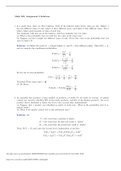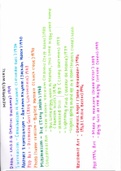Exam (elaborations)
Math 302, Assignment 2 Solutions University of British Columbia MATH 302
- Course
- Institution
Math 302, Assignment 2 Solutions 1. In a small town, there are three bakeries. Each of the bakeries bakes twelve cakes per day. Bakery 1 has two different types of cake, bakery 2 three different types, and bakery 3 four different types. Every bakery bakes equal amounts of cakes of each type. Yo...
[Show more]




